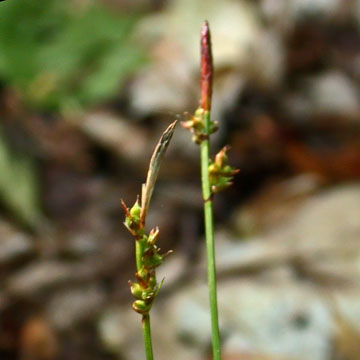

Carex communis - (image 1 of 4)
Taxonomy
Family: Cyperaceae
Section Acrocystis
Habitat
Dry to wet-mesic deciduous or mixed woods in well-drained, often sandy soils.
Associates
Distribution
Nova Scotia to MN, south to SC, KY, and AR.
Morphology
Tufted perennial, 20-50 cm, smooth and purplish at the base; stems equaling or surpassing the leaves; main leaves 3-6 mm wide; terminal spike staminate, 4-18 mm; pistillate spikes 2 or 3, more or less sessile, 5-10 mm, the lowest a little removed from the others, but none basal; middle and lower bracts mostly green, but tending to be scarious-lobed at the base; pistillate scales lance-ovate, about as long as the perigynia, obtuse to acuminate, reddish-purple with green, 3-nerved center and narrow hylaine margins; perigynia 3-10, 2.5-4 mm, the body subglobose above a stipe-like base, 2-keeled, finely hairy, abruptly prolonged into a slender beak 0.5-1 mm; achene rounded-trigonous.
Notes
Fruiting late April to June
Wetland indicator: NA
Differs from similar species, such as C. pensylvanica, by the absence elongate rhizomes (plants therefore cespitose) and the presence of wider leaves (typically more than 3 mm wide).
References
Gleason, Henry A. and A. Cronquist. 1991. Manual of Vascular Plants of
Northeastern United States and Adjacent Canada. Second Ed.
The New York Botanical Garden. Bronx, NY
|
© Michael Hough 2018 |